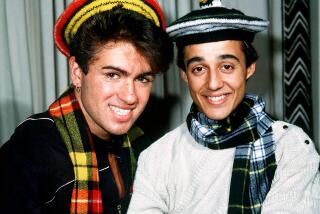Book Review : The Bloom and Doom of Three So-So Generations
The Lamberts: George, Constant and Kit by Andrew Motion (Farrar Straus Giroux, 388 pp.: $22.50).
The question âWhy?â hangs over Andrew Motionâs biography of the three figures whose heavy-lidded, dissatisfied glances stare out from the book jackets. George Lambert was an academic painter for whom Motion makes no claims to greatness. He was, Motion tells us, âthe most famous Australian painter of his day.â If that day, the early 1900s, seems remote, we are offered the fairly modest assertion that George was better than his present-day reputation would indicate.
Constant Lambert, Georgeâs son, was an English composer and conductor. As the former, he has been eclipsed by his contemporaries--Benjamin Britten, William Walton, Michael Tippett--as the latter, his reputation was less than that of Adrian Boult and Malcolm Sargent. Not a great musician, Motion tells us, but he produces another less than overwhelming claim. Constant âdid more than all but a handful of othersâ to found Brittenâs modern ballet. All but a handful? A biography of the sixth-grandest old man of the English dance?
Kit Lambert, Constantâs son, helped put together The Who. As their manager, he played an important part in keeping them together and influencing, or at least packaging, their style. In the mid-â70s, drugs, alcohol and other dissipations made him increasingly ineffective. He lost control of the group and died soon after.
Perhaps it seems harsh to speak of three second-raters; and possibly unjust, at least in the case of Constant. Yet Motionâs peculiarly ambivalent approach strongly suggests this, while at the same time it makes a breathless effort to sustain our interest.
The son of a railroad engineer, George Lambert moved to London in 1900 to develop his painting career. He took with him wife Amy, who was to play the long-suffering partner to his consciously fin-de-siecle Bohemianism. He specialized in stiff portraits for which he received modest recognition. Motion manages to praise his work and to stress its academicism and lack of spontaneity.
In World War I, he became a military artist, largely in the Middle East. After the war, he moved back to Australia, leaving his family in England. A relatively large fish in a relatively small pond, he enjoyed a measure of success and local celebrity with a variety of works, many on civic themes.
The fatherâs neglect of his children, Motion writes, deeply affected Constant. He, in turn, was similarly neglectful when he became a father, and with similarly disconcerting effects on his son, Kit.
Constant studied music, joined the splashy social set commemorated in different ways by Anthony Powell--he was the model for Moreland in âA Dance to the Music of Timeâ--and Evelyn Waugh.
Successful Works
He wrote a number of successful works incorporating jazz themes into his music, and composed a ballet for Diaghilev. He then joined with Ninette de Valois and Frederick Ashton in what eventually turned into the Sadlerâs Wells Ballet, of which he was musical director and conductor. He had a prolonged affair with Margot Fonteyn, helping to break up a fragile marriage; he drank increasingly prodigious amounts, grew professionally erratic, and died at 45.
Motion emphasizes the familyâs generational cycle of limited artistic talent, self-doubt, a need to shine and self-destructiveness. His account of Kitâs brief success as a rock manager in the â60s is competent and informed. Something of a portrait emerges, though it is mostly drugs, drink, a frenetic pursuit of hired male lovers and a grisly descent into despair and loss of control. Kit died, at 45 like his father, of a massive brain hemorrhage.
Little Feeling
The Kit section has more liveliness than the detailed but decidedly remote accounts of George and Constant. Motion treats them woodenly; he seems to have little feeling for them or their times. A few lines from Powell about the fictional Moreland contain far more life than Motionâs 130 pages about the original. Rather engagingly, he confesses his difficulty. After producing a few uncontagious examples of Constantâs sparkliness, he writes:
âThese anecdotes hardly amount to an adequate explanation of why he was regarded by all and sundry as a great and brilliant wit.â Timing must have had something to do with it, he suggests, and the fact that Constantâs audiences were usually drunk.
And so, reverting to the initial question, âWhy?â Motion invites our fascination with these stormy and erratic characters, their ability to dazzle their respective glittery worlds and their seemingly hereditary dooms.
It is unconvincing; particularly since Motion is unable to convey to us the fascination he claims to find. George, Constant and Kit were three butterflies, he suggests, whose colors amazed but who lacked staying power. But he names the colors without letting us see them. He breaks his three butterflies not on a wheel, but on a book.
More to Read
The biggest entertainment stories
Get our big stories about Hollywood, film, television, music, arts, culture and more right in your inbox as soon as they publish.
You may occasionally receive promotional content from the Los Angeles Times.










